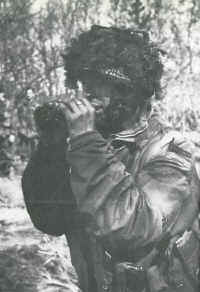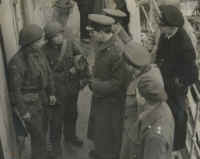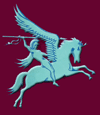[Home] [Events] [Links] [Guestbook] [Contact Us]
Airborne Forces & Operations
89 (Parachute) Field Security Section
317 (Airborne) Field Security Section
In the 1920's and 30's military thinkers developed a variety of concepts, including armoured, motorised and airborne warfare, to escape the deadlock of the trenches. Early proponents of the deployment of troops by air, both parachuted, gliderborne and air landed, included Russia, Japan and Italy. Britain appeared uninterested.
German observers at Russian exercises taking place in the mid 30's were amazed to see parachutists deploying from the fuselage and leaping from the wings of large Antonov bombers. This lead to German Army and Air Force planners constructing forces, and given the nature of Germany during the Third Reich era, a subsequent power struggle within the German military. Whilst initial paratroops were Wehrmacht Heer (Army) personnel they soon fell under the control of Marshal Goerings fledgling Luftwaffe.
Army personnel transferred to the Luftwaffe, and under Col (later General) Student, the capability to deploy parachute, glider and air landed troops (air landed troops still fell to the Army), was established. Airborne personnel were considered elite troops and were used in military propaganda programmes. Indeed, the boxer Max Schmeling, who had knocked out Joe Louis in a world heavyweight boxing match joined the Fallschirmjaeger (Louis later bested Schmeling in a re-match).
In 1939 and 1940 the use of airborne forces in the capture of Norway and the Low Countries captured the new British Prime Minister Churchill's imagination - particularly the Luftwaffe's gliderborne storming of the Belgian Fort at Eben Emael. He demanded an airborne force of 5000 men by Winter 1940. The formation of this force was not feasible in the timescale - but the parachute school at Ringway, Manchester, was established. British parachutists conducted intense fitness training and dry training in a hanger, conducted static balloon jumps, and 5-6 jumps from a transport or converted bomber including a night jump before the awarding of parachute qualification wing and wearing the maroon beret.
In 1941 German parachute and Gliderborne forces were in action in Greece, at the Corinth Canal, and during the daring, but costly Op MERCURY, the invasion of Crete. Fallschirmjaeger were tasked with capturing airfields along the northern coast of the island and allowing the rapid reinforcement by airlanded troops. Large numbers of Fallschirmjaeger and aircraft were lost during this operation, majorly affecting their subsequent employment and reducing their offensive role.
Progressively, more impetus was applied to the British airborne capability, with developments in arms and equipment. Additionally some British airborne personnel were trained in the US as the US capability was some months ahead of the British. British parachute units were all volunteer, with whole established infantry battalions being given the opportunity. A certain amount of cross fertilization was necessary and some officers were required to drop rank in order to join parachute (or indeed glider units).
Initially British parachute units retained their original Regimental identity, but in mid 1942 were renamed Parachute Battalions as part of the Army Air Corps. The title Parachute Regiment came later that year. The Army Air Corps covered both the Parachute and Glider Pilot Regiments. Initially it was determined the use of gliders, which could deploy a formed, equipped section of troops and carry heavy supplies was the way ahead, rather than parachutists which took a time to form up if scattered on a drop an could not carry heavy equipment. However, without the element surprise it was quickly found that gliders became easy targets for the well equipped German Flak batteries. Both British and American Airborne units used a mixture of both, glider and parachute deployed forces.
In the cold late February of 1942, members of the then 2nd Parachute Battalion conducted Op BITING later known as the Bruneval Raid, to acquire German RADAR secrets. Completely successful, this raid into occupied France and evacuated by Royal Navy gunboats won the Parachute Regiment its colours.
British and US airborne forces were operationally deployed in large numbers in North Africa and Italy (and by the US in the Far East) in 1942/3. But, it was in Operations OVERLORD and MARKET GARDEN where British and US airborne forces were crucial to the success of the missions.
The US had created 2 full US size airborne divisions for operations in the European Theatre of Operations, and was on its way to a 3rd. 82, 101 and later 17 Airborne Divisions were deployed in N Africa, Italy France (NW and S) Holland, and Germany. Britain had the 1st and 6th Airborne Divisions.
These British Divisions included; 2 Parachute Brigades, each with 3 infantry battalions per brigade, and an Airlanding Brigade with 3 Gliderborne infantry battalions. Full combat and supporting arms, Royal Artillery, Intelligence, and Reconnaissance, Glider Pilots, Provost. Logistic support from Royal Army Ordnance Corps and Royal Army Service Corps units, Engineering from Royal Engineers and Royal Electrical and Mechanical Engineers, Communications from Royal Signals, Field Ambulance and Hospital services Royal Army Medical Corps, and other smaller Corps.
1st Airborne Division was trained throughout 1941/2 and initially deployed in N Africa as part of 1st Army in Algeria and Tunisia, it then took part in operations in Sicily and Italy, before being recalled to England for preparations for operations in North West Europe, culminating in Op MARKET GARDEN. 6th Airborne Division was formed in mid 1943 specifically for Op OVERLORD and after rest and refit took place in the final European airborne operation of WW2, Op VARSITY.
Whereas British Divisions were employed upon individual operations US Divisions, reflecting their scale were deployed on each operation, with 82nd and 101st on both Ops OVERLORD and MARKET GARDEN, and VARSITY and with 17th Division ready in time for VARSITY.
In the Far East despite early use of Airborne forces by Japan, airborne activity was limited until the latter stages when US forces staged large scale landings in support of the island hopping campaign, culminating with the large scale operations on the Philippine Island of Corregidor.
The airborne operations for both D-Day (OVERLORD), including the Ox & Bucks classic glider borne coup-de-main at Pegasus Bridge, and the battle of the bridges (MARKET GARDEN) and the stand of the 2nd Battalion the Parachute Regiment at Arnhem, are well documented elsewhere, but needless to say have entered the annals of military history, and will be studied for years to come.
Airborne operations had proved themselves effective in context during WW2, but were also notably costly in men and materiel. The complications of delivering a fighting force behind your enemy's lines, but with sufficient firepower and self sustainment to prove militarily efficient, eventually proved too much for the concept to survive the Cold War.
British Airborne Soldier
Parachute Training
Operation BITING; debriefing
Emplaning a Glider
Glider Take-off
Gliders in Flight
1st
Airborne Division,
Buckingham Palace,
6th December 1944
Glider-borne troops prior to take off




![Glider[1].jpg (44289 bytes)](images/Pic_Historic/Pic_Historic_th/Glider1_small.jpg)
![Glider[2].jpg (10332 bytes)](images/Pic_Historic/Pic_Historic_th/Glider2_small.jpg)
![Glider[3].jpg (18640 bytes)](images/Pic_Historic/Pic_Historic_th/Glider3_small.jpg)




